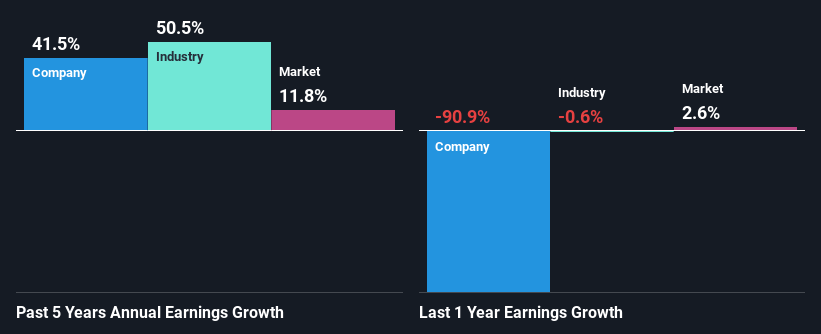Hapag-Lloyd Aktiengesellschaft's (ETR:HLAG) Stock Is Going Strong: Have Financials A Role To Play?
Hapag-Lloyd (ETR:HLAG) has had a great run on the share market with its stock up by a significant 27% over the last three months. As most would know, fundamentals are what usually guide market price movements over the long-term, so we decided to look at the company's key financial indicators today to determine if they have any role to play in the recent price movement. In this article, we decided to focus on Hapag-Lloyd's ROE.
ROE or return on equity is a useful tool to assess how effectively a company can generate returns on the investment it received from its shareholders. In other words, it is a profitability ratio which measures the rate of return on the capital provided by the company's shareholders.
View our latest analysis for Hapag-Lloyd
How To Calculate Return On Equity?
The formula for ROE is:
Return on Equity = Net Profit (from continuing operations) ÷ Shareholders' Equity
So, based on the above formula, the ROE for Hapag-Lloyd is:
6.9% = €1.4b ÷ €20b (Based on the trailing twelve months to March 2024).
The 'return' is the yearly profit. So, this means that for every €1 of its shareholder's investments, the company generates a profit of €0.07.
What Is The Relationship Between ROE And Earnings Growth?
We have already established that ROE serves as an efficient profit-generating gauge for a company's future earnings. We now need to evaluate how much profit the company reinvests or "retains" for future growth which then gives us an idea about the growth potential of the company. Generally speaking, other things being equal, firms with a high return on equity and profit retention, have a higher growth rate than firms that don’t share these attributes.
A Side By Side comparison of Hapag-Lloyd's Earnings Growth And 6.9% ROE
When you first look at it, Hapag-Lloyd's ROE doesn't look that attractive. A quick further study shows that the company's ROE doesn't compare favorably to the industry average of 22% either. Despite this, surprisingly, Hapag-Lloyd saw an exceptional 42% net income growth over the past five years. So, there might be other aspects that are positively influencing the company's earnings growth. For example, it is possible that the company's management has made some good strategic decisions, or that the company has a low payout ratio.
We then performed a comparison between Hapag-Lloyd's net income growth with the industry, which revealed that the company's growth is similar to the average industry growth of 51% in the same 5-year period.
Earnings growth is a huge factor in stock valuation. It’s important for an investor to know whether the market has priced in the company's expected earnings growth (or decline). This then helps them determine if the stock is placed for a bright or bleak future. One good indicator of expected earnings growth is the P/E ratio which determines the price the market is willing to pay for a stock based on its earnings prospects. So, you may want to check if Hapag-Lloyd is trading on a high P/E or a low P/E, relative to its industry.
Is Hapag-Lloyd Making Efficient Use Of Its Profits?
The high three-year median payout ratio of 55% (implying that it keeps only 45% of profits) for Hapag-Lloyd suggests that the company's growth wasn't really hampered despite it returning most of the earnings to its shareholders.
Moreover, Hapag-Lloyd is determined to keep sharing its profits with shareholders which we infer from its long history of five years of paying a dividend. Looking at the current analyst consensus data, we can see that the company's future payout ratio is expected to rise to 68% over the next three years. Therefore, the expected rise in the payout ratio explains why the company's ROE is expected to decline to 3.6% over the same period.
Conclusion
In total, it does look like Hapag-Lloyd has some positive aspects to its business. That is, quite an impressive growth in earnings. However, the low profit retention means that the company's earnings growth could have been higher, had it been reinvesting a higher portion of its profits. With that said, on studying the latest analyst forecasts, we found that while the company has seen growth in its past earnings, analysts expect its future earnings to shrink. Are these analysts expectations based on the broad expectations for the industry, or on the company's fundamentals? Click here to be taken to our analyst's forecasts page for the company.
Have feedback on this article? Concerned about the content? Get in touch with us directly. Alternatively, email editorial-team (at) simplywallst.com.
This article by Simply Wall St is general in nature. We provide commentary based on historical data and analyst forecasts only using an unbiased methodology and our articles are not intended to be financial advice. It does not constitute a recommendation to buy or sell any stock, and does not take account of your objectives, or your financial situation. We aim to bring you long-term focused analysis driven by fundamental data. Note that our analysis may not factor in the latest price-sensitive company announcements or qualitative material. Simply Wall St has no position in any stocks mentioned.

 Yahoo Finance
Yahoo Finance 
